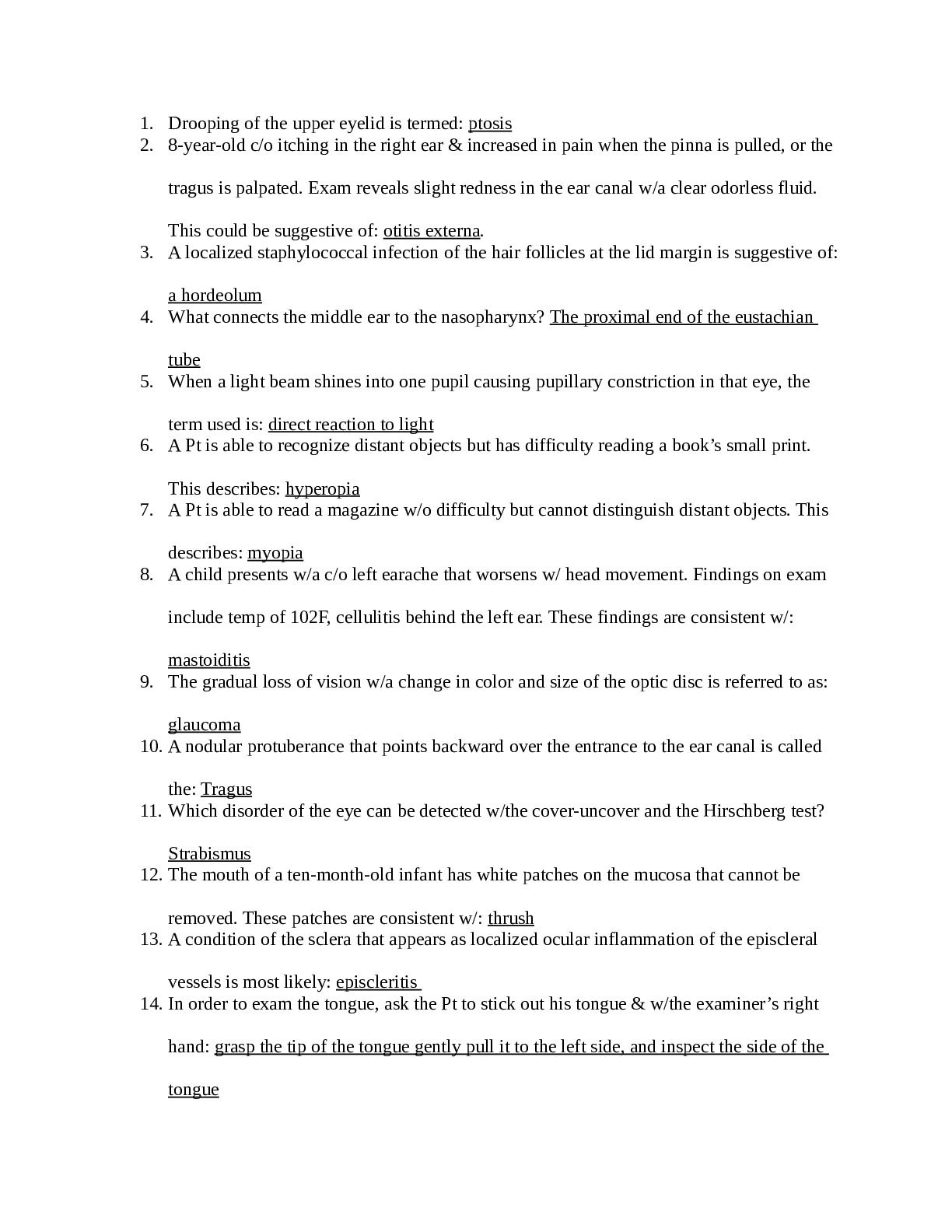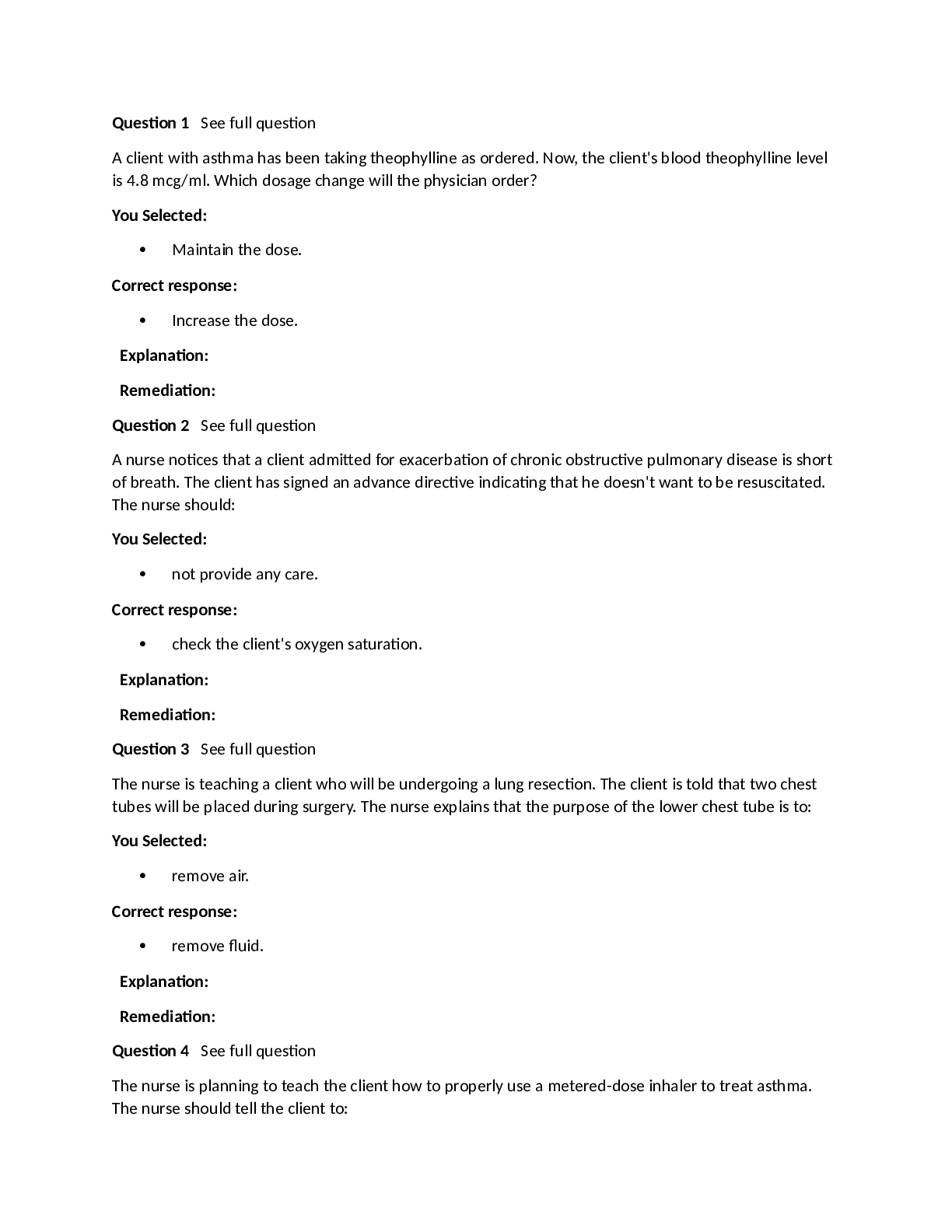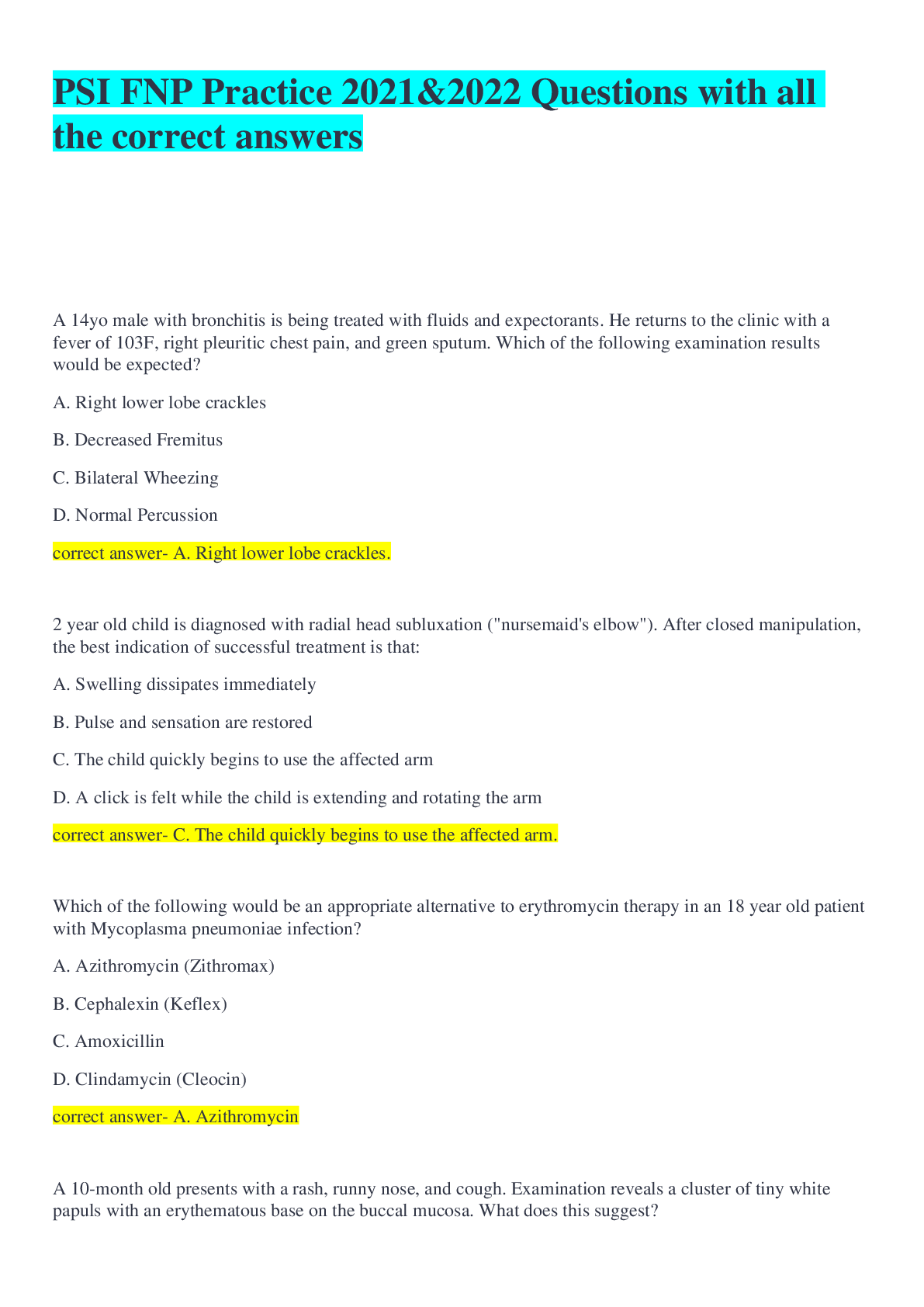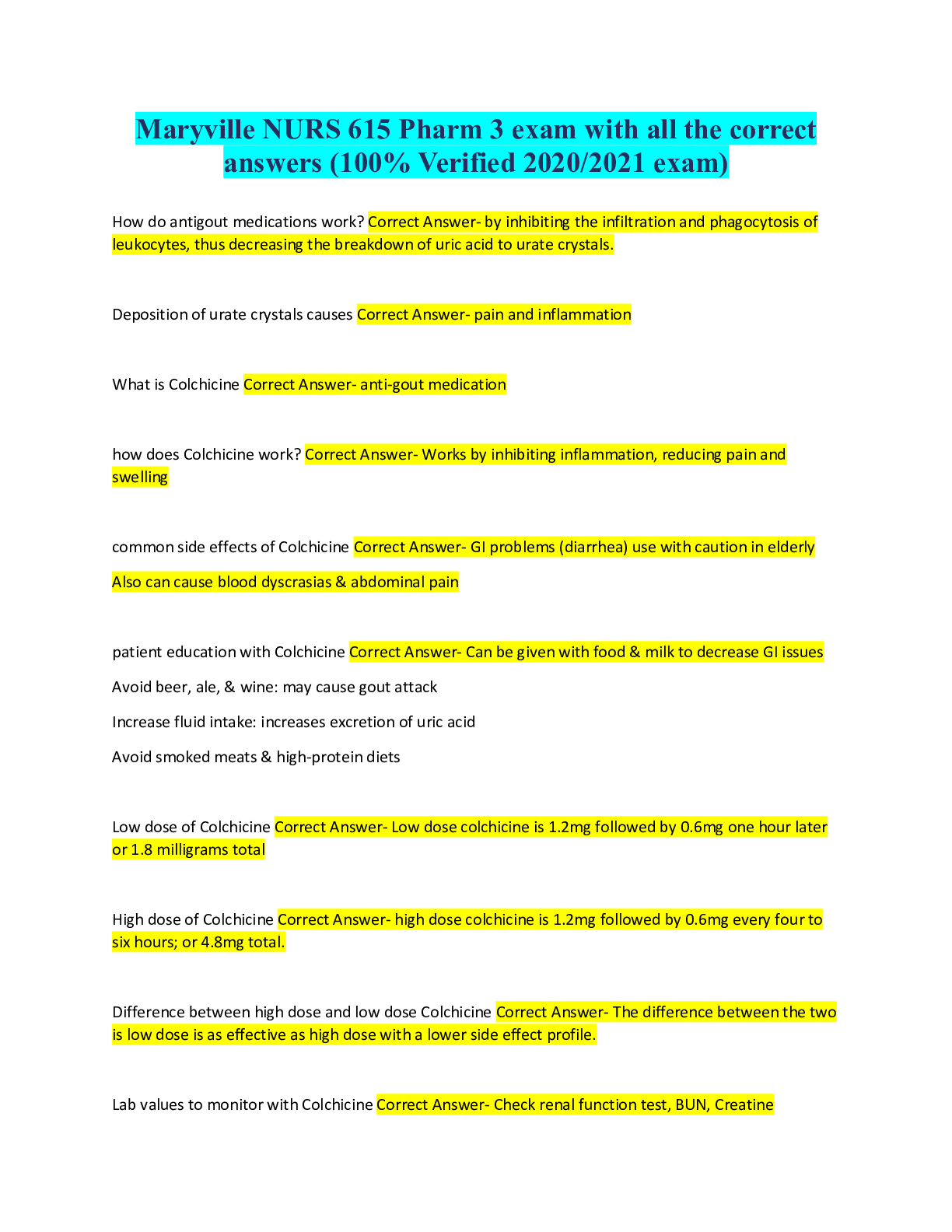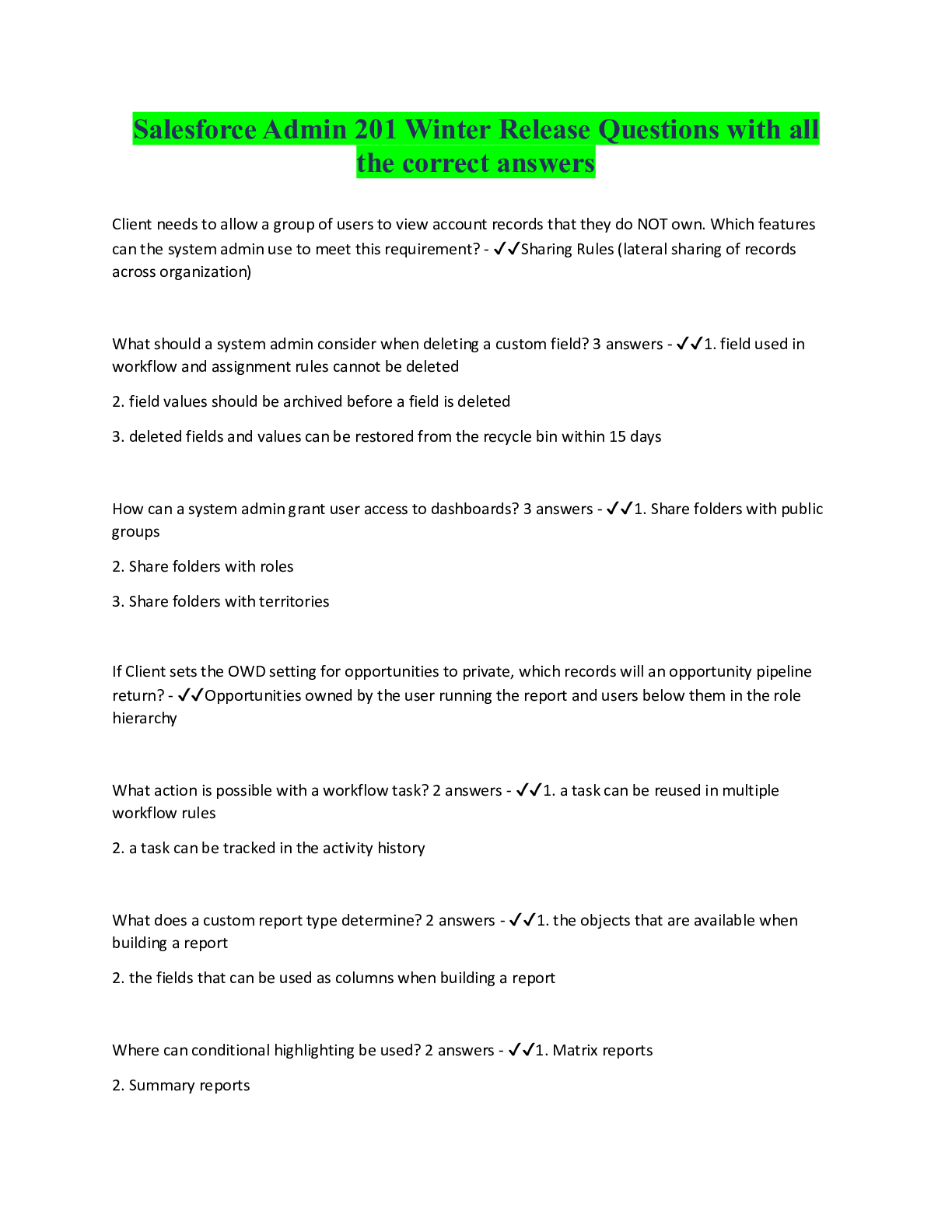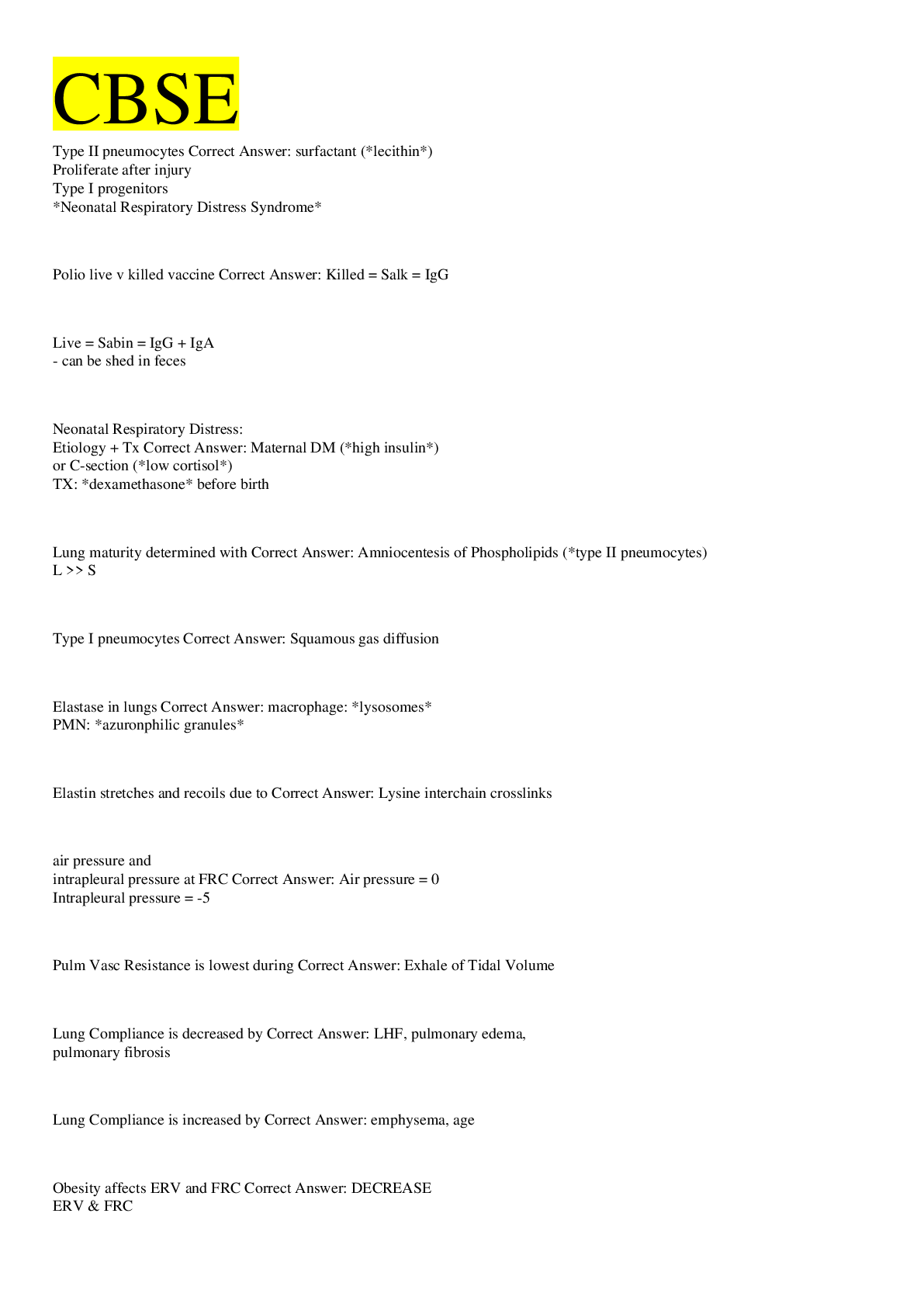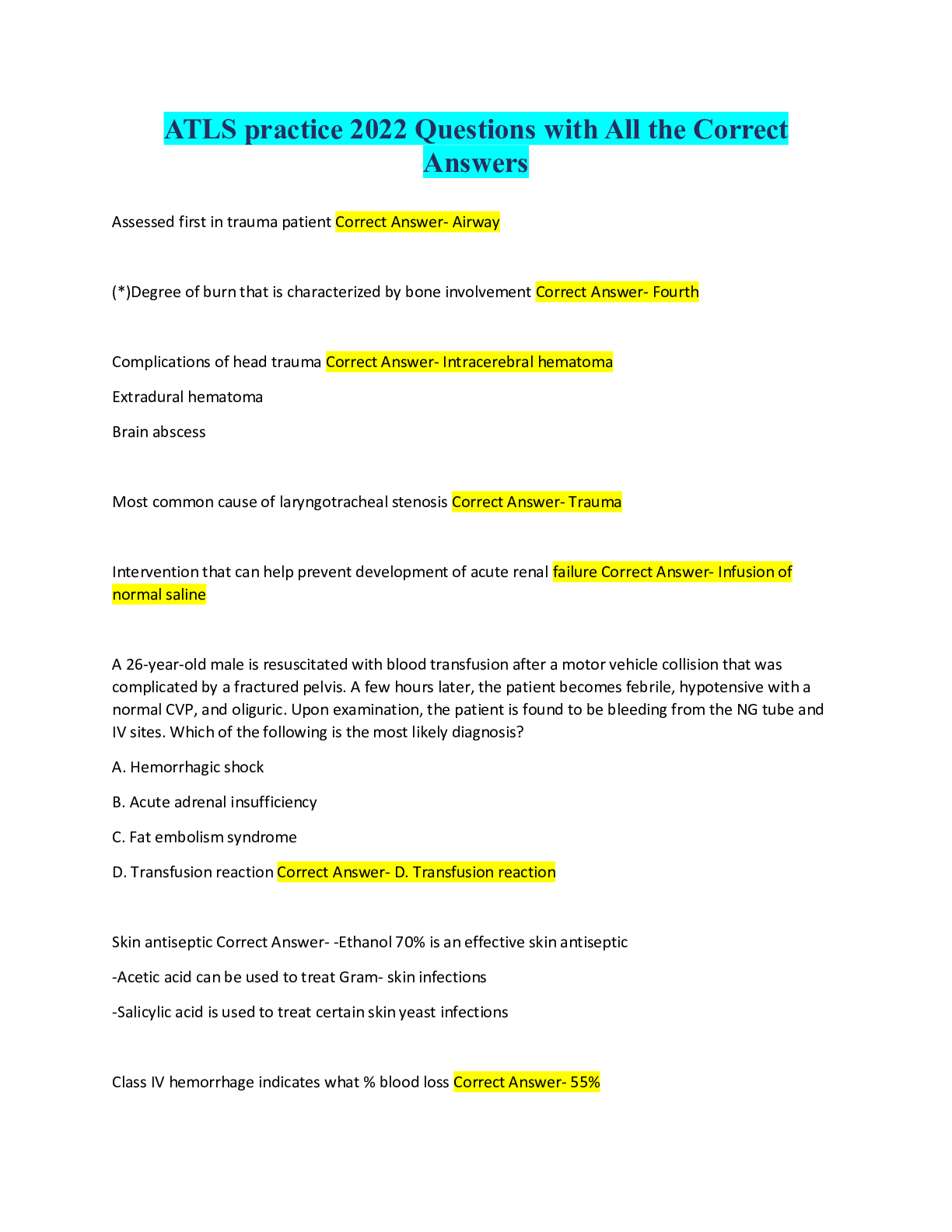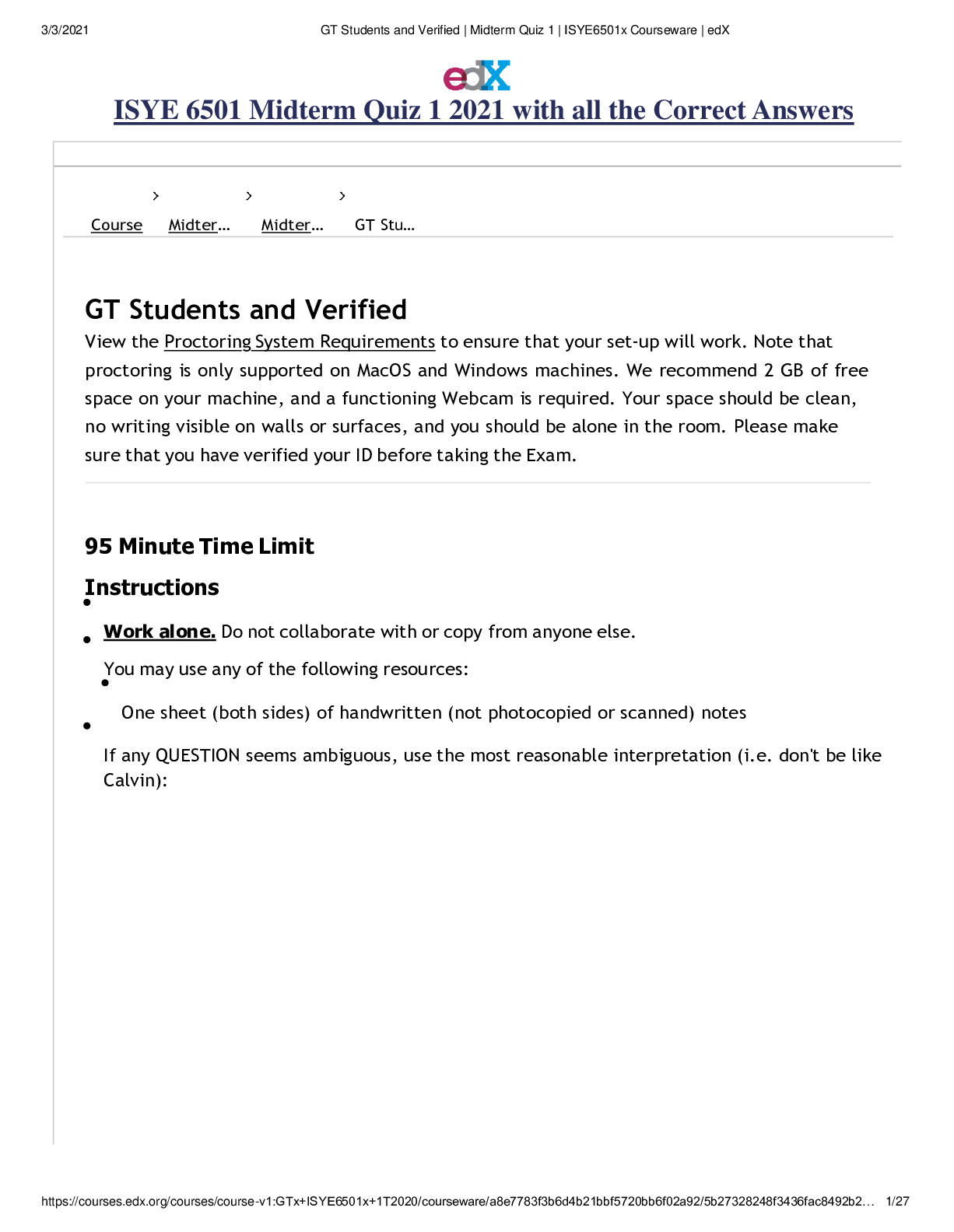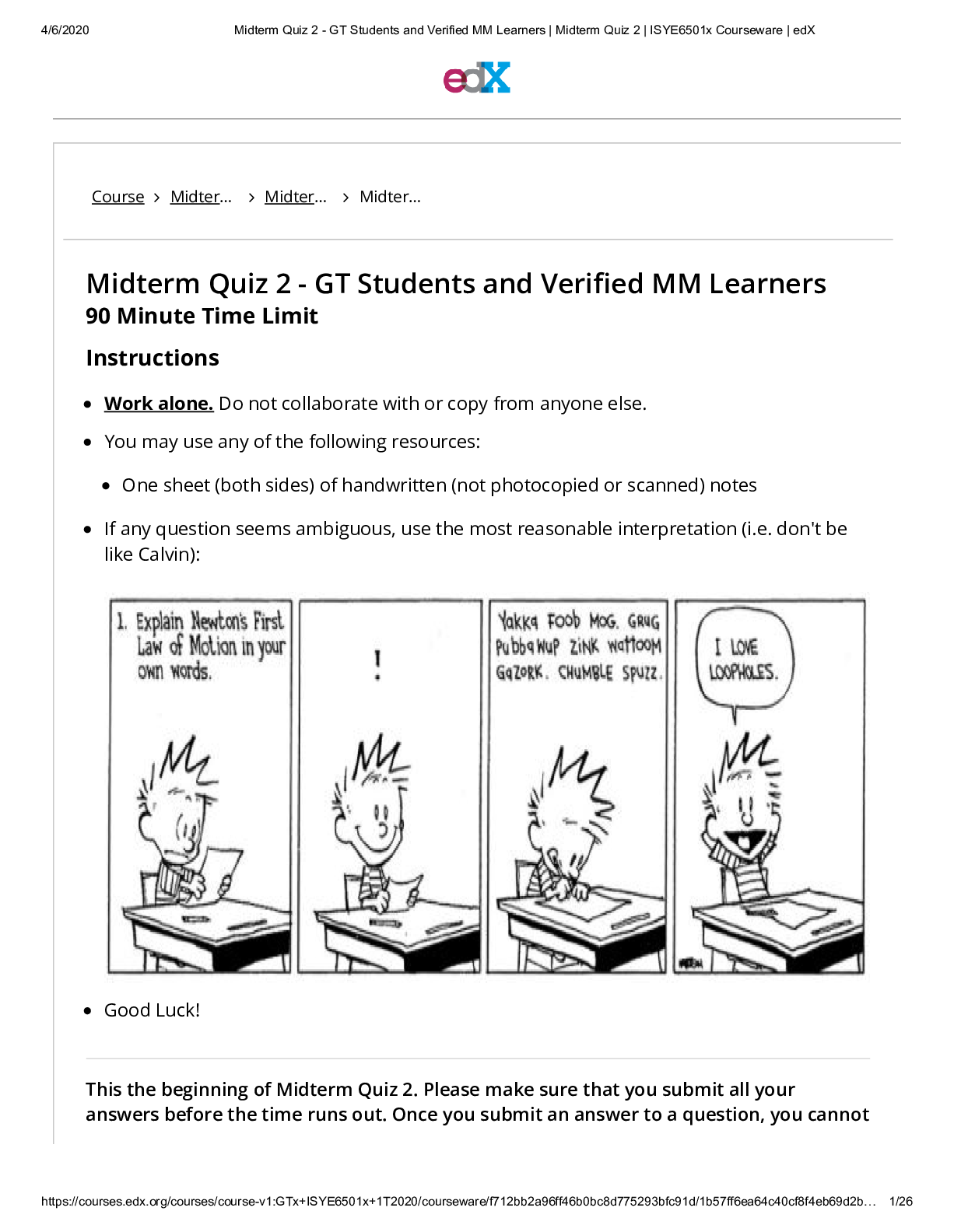*NURSING > QUESTIONS & ANSWERS > NSG 5003 Unit III Mechanisms of Self-Defense questions with all the correct answers.(100% correct,la (All)
NSG 5003 Unit III Mechanisms of Self-Defense questions with all the correct answers.(100% correct,latest update 2020/2021)
Document Content and Description Below
Unit III: Mechanisms of Self-Defense 1. Which of the following is an example of a physical barrier? A. Antibacterial fatty acids B. Lysozymes in tears C. Epithelial cells D. Earwax 2. Which ... statement is true regarding the inflammatory response? A. Inflammatory response is the third line of defense. B. Inflammatory response relies on cellular components only. C. Inflammatory response generates a nonspecific response. D. Inflammatory response occurs at healthy tissue. 3. Which complement factor is considered an anaphylatoxin? A. C3a B. C1 C. C7 D. C9 4. Which receptor is expressed on macrophages and facilitates recognition and phagocytosis of bacterial pathogens? A. Complement receptors B. Scavenger receptors C. Toll-like receptors D. Pattern recognition receptors 5. Which statement regarding mast cells is true? A. Histamine causes vasoconstriction. B. Mast cells are found only in blood vessels. C. Snake bites, bee venoms, and toxins may cause activation. D. Mast cells are not involved in allergic reactions. 6. Which term describes an acidic sulfur-containing lipid that produces effects similar to histamine? A. Leukotriene B. Prostaglandin C. Adhesion molecule D. Phagocyte 7. Which statement is true regarding neutrophils? A. Neutrophils are agranular. B. Neutrophils are the predominant phagocytes of early inflammation. C. Neutrophils are the largest blood cells. D. Neutrophils enter the site of injury after lymphocytes and macrophages. 8. What biochemical messenger is produced by macrophages and lymphocytes in response to a bacterial pathogen? A. Interleukins B. Interferons C. Chemokines D. Tumor necrosis factor 9. Chronic inflammation is characterized by a(an): A. Lack of giant cells B. Absence of exudate C. Dense infiltrate of lymphocytes and macrophages D. Inflammation that lasts less than 2 weeks 10. Which of the following are not natural barriers? (Select all that apply.) A. Physical B. Resistance C. Biochemical D. Mechanical 11. Which characteristics are observable of vascular injury and inflammation? (Select all that apply.) A. Redness B. Coolness to the touch C. Warmth to the touch D. Increased swellin g E. Pain 12. Which pathways activate the complement system? (Select all that apply.) A. Antigen-antibody B. Classical C. Lectin D. Alternative 13. Which functions of the clotting system are exhibited at the site of injury or inflammation? (Select all that apply.) A. Prevents the spread of infection to adjacent tissues. B. Traps microorganisms at the site of greatest inflammatory cell activity. C. Prevents clot formation at the site of injury. D. Provides a framework for future repair and healing. 14. Which of the following are systemic effects of inflammation? (Select all that apply.) A. Abscess formation B. Fever C. Leukocytosis D. Increased levels of plasma proteins E. Decreased levels of plasma proteins 15. Which is a foreign or nonself substance? A. Immunoglobulins B. Lymphocytes C. Antibodies D. Antigens 16. Which statement is true regarding the immune response in humans? A. Before birth, lymphocytes are not produced. B. B lymphocytes come from the thymus. C. The thymus releases mature lymphocytes. D. Generation of clonal diversity occurs in primary lymphoid organs. 17. Which statement best describes the cells and their functions in the humoral arm of the immune system? A. Cells undergo differentiation and develop into subpopulations. B. Cells attack cancerous cells. C. Antibodies are primarily responsible for protection. D. Cells in the humoral arm are also called cellular immunity. 18. Which term describes the type of immunity that occurs when preformed antibodies are transferred from a donor to a recipient? A. Passive B. Active C. Memory D. Cellular 19. What is the precise portion of the antigen that is configured for recognition and binding of an antibody? A. Paratope B. Epitope C. Self-antigen D. Immunogen 20. Which antigen is too small to initiate an immune response? A. Carrier B. Allergen C. Hapten D. Self-antigen 21. Which statement is true regarding immunoglobulin A (IgA) antibodies? A. IgA-2 is predominantly found in blood. B. IgA-1 is predominantly found in the body's secretions. C. The J chain anchors together the IgA molecules. D. The gamma heavy chain is predominant. 22. It is true that immunoglobulin E (IgE) is: A. Designed to protect the host from large viruses. B. The primary cause of common allergies. C. The only inflammatory cell that can damage a virus. D. Specifically designed to prevent the invasion and attachment of pathogens through mucous membranes. 23. Which statement is true regarding aging and the immune system function? A. Older adults have decreased circulating antibodies. B. T-cell function is increased. C. Antibody production to specific antigens is inferior. D. Response to infection is rapid. 24. Which criteria influence the degree of immunogenicity? (Select all that apply.) A. Foreignness to the host B. Appropriate size C. Appropriate quantity D. Chemical simplicity E. Chemical complexity 25. Which of the following are molecular classes of immunoglobulins? (Select all that apply.) A. IgC B. IgD C. IgE D. IgM E. IgN 26. Which definition is true? A. Allergy means the deleterious effects of hypersensitivity. B. Immunity means an altered immunologic response. C. Hypersensitivity means the protective response to an antigen. D. Autoimmunity means the normal response to foreign antigens. 27. Which statement is true regarding hypersensitivity reactions? A. They require sensitization against a particular antigen. B. They occur after the primary immune response. C. Reactions are always delayed. D. The most delayed reaction is anaphylaxis. 28. Which statement best describes a type I reaction? A. Most type I reactions are mediated by IgA. B. Most type I reactions are allergic. C. Most occur against medications. D. Seldom does this type contribute to autoimmune diseases. 29. What antibody binds to a mast cell? A. Cytotropic B. Allergen C. Antigen D. Fc 30. Which statement is true regarding atopic individuals? A. If one parent has allergies, then a 4% chance exists that the offspring will have similar allergies. B. If two parents have allergies, then a 50% chance exists that their offspring will have similar allergies. C. Atopic individuals tend to produce higher quantities of IgE. D. No genes are associated with an atopic state. 31. Which statement is true of serum sickness? A. The formation of immune complexes in the blood cause serum sickness. B. It is the deposition of complexes in the blood vessels. C. It occurs through cytotoxic T cells. D. It binds antigen to the cell surface. 32. The Arthus reaction is an example of which type of sensitivity reaction? A. I B. II C. III D. IV 33. Which statement is true regarding a type IV allergic reaction? A. Is immediate in its action. B. Is infiltrated with B cells. C. Has a red, soft center. D. Can be transferred by cells. 34. Which is an example of an alloimmune disease? A. Tuberculin reaction B. Graves disease C. Contact dermatitis D. Penicillin allergy 35. Which statement is true regarding unmatched packed red blood cell (RBC) transfusions? A. Only three different RBC antigens have been identified. B. Approximately 80 major carbohydrate antigens exist. C. People with O type blood have neither A or B antigens. D. A person with type A blood contains anti-O antibodies. 36. Histamine release leads to which of the following? (Select all that apply.) A. Bronchial smooth muscle contraction B. Bronchoconstriction C. Decreased vascular permeability D. Vasoconstriction E. Edema 37. Which term describes an agent's ability to produce disease? A. Virulence B. Pathogenicity C. Infectivity D. Immunogenicity 38. Which statement is true regarding bacteremia? A. It occurs with a normal defense system of the body. B. Gram-positive bacteria typically cause bacteremia. C. Endotoxins often cause symptoms such as vasodilation. D. Symptoms include increased blood pressure. 39. Which statement regarding viruses is true? A. Viruses are less common than bacterial infections. B. Viruses actively produce exotoxins. C. Viruses bypass many defense mechanisms by developing intracellularly. D. Viruses contain all their genetic information in ribonucleic acid (RNA). 40. Which statement regarding fever is true? A. Fever is a failure of the body to regulate temperature. B. An endogenous pyrogen may produce fever. C. The body's central thermostat is the pituitary gland. D. Fever is a failure of the body's defense system. 41. What contributes to antibiotic-resistant pathogens? A. Inadequate sanitation B. Genetic mutation C. Loss of multidrug transporters D. Limited use of antibiotics 42. The stages of pathologic infection include which of the following? (Select all that apply.) A. Invasion B. Death C. Colonization D. Metastasis E. Multiplication 43. Which of the following are mechanisms of antigenic variation? (Select all that apply.) A. Siderophoric switching B. Mutation C. Recombination D. Gene switching 44. Which mechanisms are used by viruses to evade the immune response? (Select all that apply.) A. Rapid division B. Antigenic specificity C. Self-protein coat D. Immune suppression E. Lipopolysaccharide 45. What is the definition of the reactive response? A. Mounting a response in anticipation of a stressor B. Mounting a response in reaction to a stressor C. Mounting a response to a learned stressor D. Mounting a response to a physical stressor 46. A stress response is initiated in what part of the nervous system? A. Peripheral nervous system B. Exocrine system C. Parasympathetic nervous system D. Central nervous system 47. A stress response results in the stimulation of which sympathetic nervous system receptors? A. α-Adrenergic receptors B. β-Receptors C. Adrenocorticotropic hormone (ACTH) D. Growth hormone (GH) 48. Which statement is true regarding the effects of circulating epinephrine in the body? A. The heart rate will slow down. B. The heart's contractility will decrease. C. Blood vessels to skeletal muscle will constrict. D. Transient hyperglycemia will result. 49. Which statement is true regarding how cortisol reacts when activated by ACTH? A. Cortisol is plasma bound to corticotropin. B. Gluconeogenesis is halted. C. Cortisol increases blood glucose. D. Cortisol decreases protein synthesis. 50. Which statement is true regarding the immune system in response to stress? A. T-helper 1 (Th1) cells increase. B. A shift in Th1 cells occurs. C. The immune system is not affected. D. Cortisol is released. 51. Which of the following is a function of norepinephrine? A. Increases contraction of the heart B. Constricts smooth muscle in all blood vessels C. Secretes steroid hormones D. Stimulates adrenal medulla 52. Which statement regarding corticotropin-releasing hormone (CRH) and its influence on the immune system is true? A. CRH is also released from peripheral inflammatory sites. B. CRH causes vasoconstriction. C. CRH causes decreased vascular permeability. D. Red blood cells are the peripheral targets. 53. Which statement is true regarding stress and the immune system? A. Seasonal allergies are related to stress. B. Cardiovascular disease is one condition that is related to stress. C. The level of proinflammatory cytokines is decreased. D. Negative emotions cause few alterations in cytokine production. 54. Which of the following are stages in the development of the general adaptation syndrome? (Select all that apply.) A. Alarm B. Exposure C. Resistance D. Exhaustion [Show More]
Last updated: 1 year ago
Preview 1 out of 18 pages
.png)
Reviews( 0 )
Document information
Connected school, study & course
About the document
Uploaded On
Jan 10, 2021
Number of pages
18
Written in
Additional information
This document has been written for:
Uploaded
Jan 10, 2021
Downloads
0
Views
26


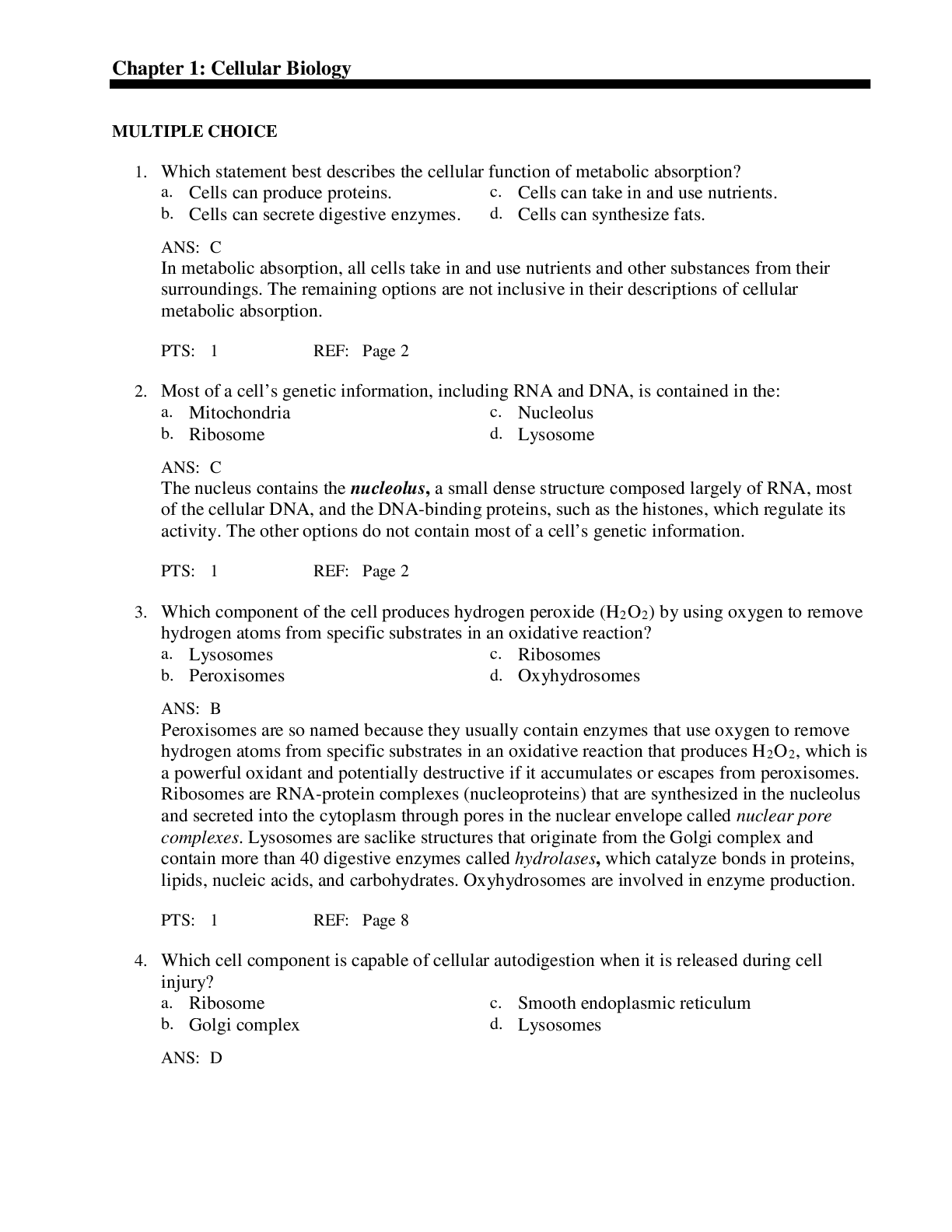
.png)
